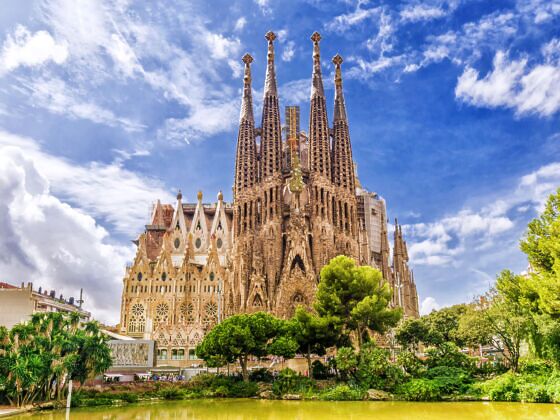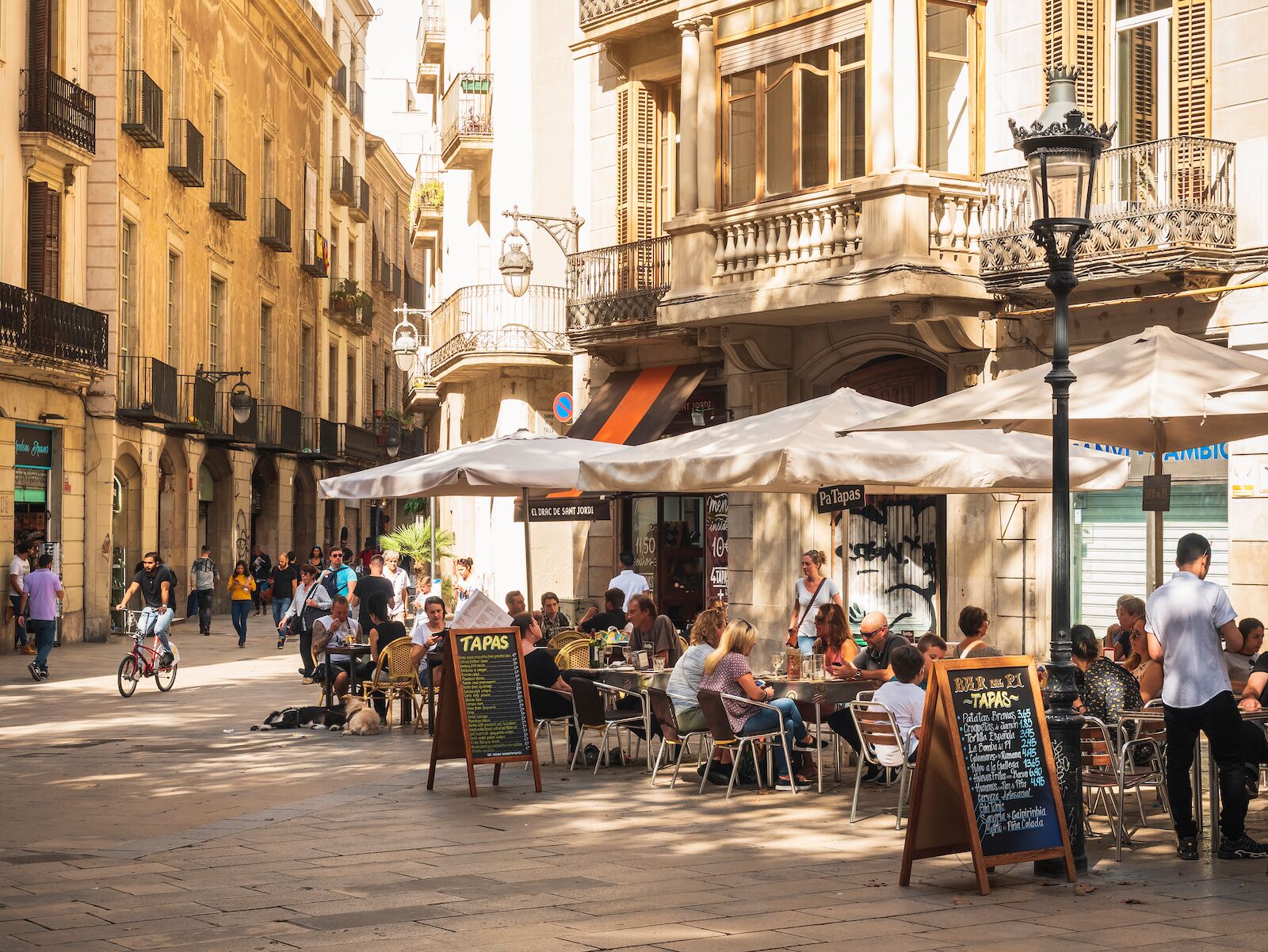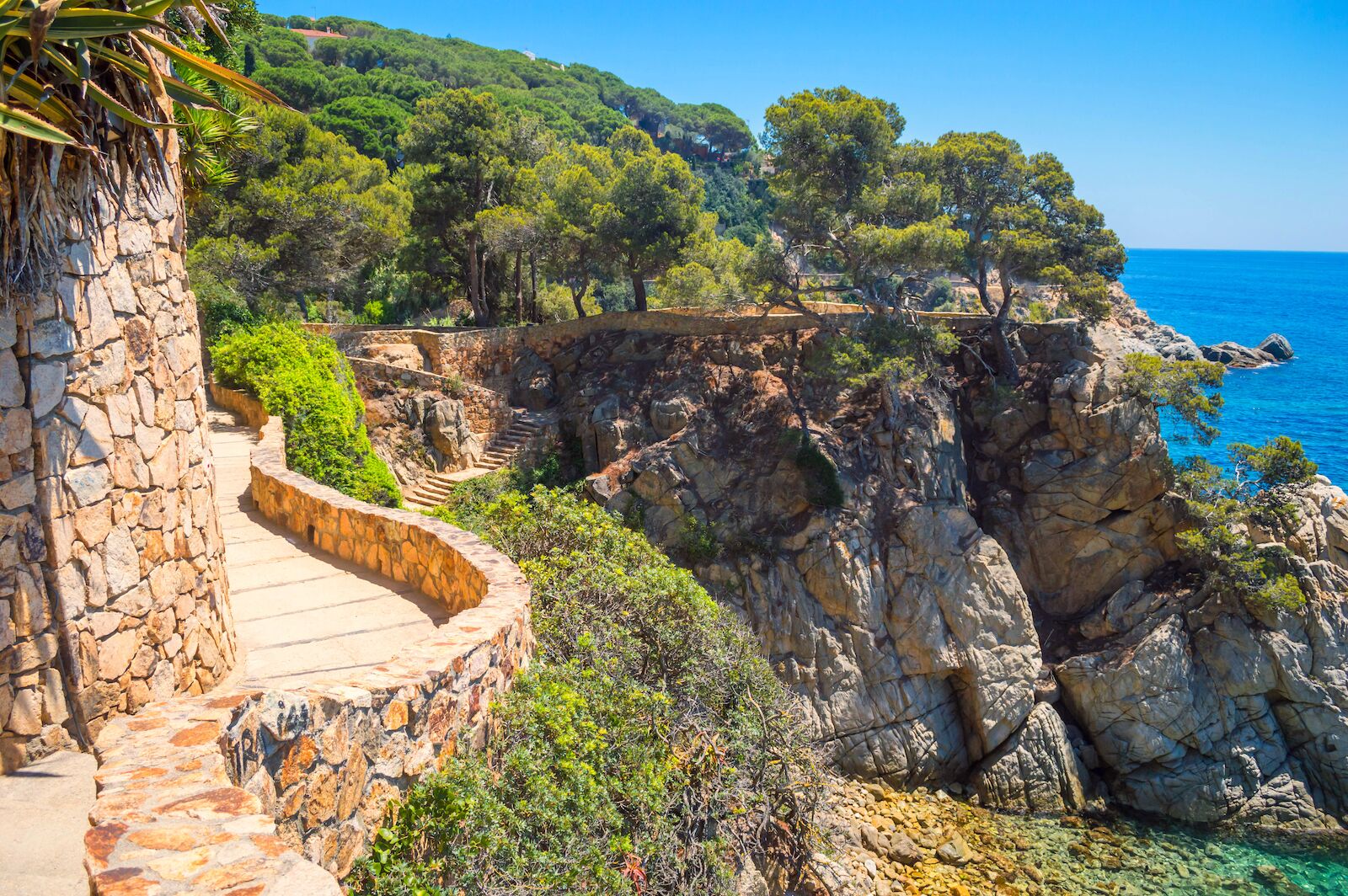If the three Spanish regions where the Catalan language is spoken suddenly became independent from Spain, the resulting country would instantly turn into one of the world’s top-10 tourist destinations. In 2019, almost 43 million international travelers made it to the Mediterranean-washed shores of Catalonia, the Valencian Region, and the Balearic Islands. A figure on par with the entire population of Spain.

Follow This Guide to Catalan to Better Navigate Barcelona Like a Local
Yet, despite Catalan-speaking Spain’s whooping popularity, many visitors remain blissfully unaware of its millenary linguistic heritage. Worse, it is not uncommon for tourists to mistake Catalan as a dialect of Spanish (in fact, it derives directly from Vulgar Latin). And while it is true that Spanish is universally spoken and English will take you a long way, even a clumsy “bon dia” — good morning in Catalan — will have everyone nodding appreciatively. This traveler’s guide to the Catalan language is all you need to venture off the beaten tracks of La Rambla and Sagrada Família and into the locals’ hearts.
The author:
Marcos Bartolomé has lived in Barcelona for less than two years but he is often mistaken as a native Catalan speaker. “Is menorquí [a dialect of Catalan] your mother tongue?”, asked his examiner after he completed the oral exam declaring him officially proficient. He taught himself the language before moving to Catalonia through music lyrics and the Catalan public broadcaster’s satirical TV shows. As a native Asturian, he is an ardent champion of linguistic minorities and speaks seven languages himself. He has conducted research on the Moroccan project to revitalize the Tamazight language at Georgetown University, where he graduated with a Master’s in Arab Studies, and has been a Spanish teacher at a public high school on the French East African island of Mayotte.
- Where is the Catalan language spoken?
- The different types of Catalan
- Which language is Catalan closest to?
- Catalan vs. Spanish: The Catalan alphabet
- Catalan language pronunciation guide
- How to say “thank you”, “good afternoon”, “hello”, etc. in the Catalan language?
- Catalan words, sentences, and phrases for eating and drinking to your heart’s content
- Catalan words and sentences you need to find a good accommodation
- Catalan words and sentences you’ll need to get around
- Numbers in Catalan and words you’ll need when shopping
- Catalan words and sentences you’ll need if you hike
Where is the Catalan language spoken?
Contrary to what its name suggests, Catalan is by no means confined to Catalonia, whose constitution grants it the status of “native language.” So does the Valencian Region — under the label of valencià (Valencian) — and the Balearic Islands, where the distinct local varieties of the Catalan language are named after each island: mallorquí (Mallorca), menorquí (Menorca), and so forth. Across these regions, Catalan has a prominent — yet uneven — presence in school, everyday life, and the media alongside Castilian Spanish. Pockets of the Catalonia-adjacent region of Aragon are also Catalan-speaking.
All in all, more than one in ten Spaniards speaks a variety of Catalan at home, an impressive figure given Spanish dictator Francisco Franco’s almost four-decade-long war on linguistic diversity in the country.
Yet, this is only half of the story. Owing to the Mediterranean expansion of the Kingdom of Aragon in the Middle Ages, to this day Catalan is spoken in places as far from the language’s cradle as the city of Alghero (L’Alguer, in Catalan) on the Italian island of Sardinia. Catalan can also regularly be heard in New York’s UN General Assembly, or the Eurovision, as it is the only official language of the Principality of Andorra, a microstate sandwiched between Spain and France. Lastly, around five percent of France’s Pyrénées-Orientales – which before 1659 belonged to the Crown of Aragon — are also Catalan-speaking.
Just like any other language, Catalan reflects the stories of its speakers. As most of the Iberian Peninsula was for centuries under Arab control, modern-day Catalan is rich in Arabic loan words. On the island of Menorca, ruled by the British for almost a century until 1802, people still use (catalanized) English words like “xoc” (chalk) or “escrú” (screw).
The different types of Catalan
The Catalan language is split into two groups of dialects: Eastern and Western Catalan. The first meridian east roughly marks the border between both. Eastern Catalan provides the basis for standard Catalan.
Apart from this official division, Catalan speakers also refer to other varieties:
- Xava: A word used — often derogatorily — to describe a distinct type of Catalan found in Greater Barcelona. As Spain’s earliest industrial hub, the Catalan capital received a wealth of Castilian-speaking workers from the economically disenfranchised South. The language contact resulting from this rural exodus gave way to a variety of Catalan heavily influenced by Spanish.
- Català salat: Literally salted or seasoned Catalan, it refers to the varieties where definite articles are pronounced with an “s” instead of with an “l” ( e.g. “sa platja” instead of “la platja” for the beach). Although now confined to the Balearic Islands, this dialect used to be found on mainland Spain too. Place names like Sant Esteve Sesrovires (famous singer Rosalía’s birthplace) are proof of this heritage.
- Lleidatà: Heard of Alcarràs, the first Spanish movie to win the Berlin Festival’s Golden Bear since 1983? Well, Carla Simón’s masterpiece was filmed in lleidatà, a Western dialect characterized by the shift of a verb’s third person singular final “a” into an “e”. “Ell torna” (he comes back) becomes “ell torne”).
Which language is Catalan closest to?
Catalan’s closest living language is Occitan, spoken in Catalonia’s Val d’Aran, Southern France, Monaco, and some valleys in Italy. Together, Catalan and Occitan form the Occitano-Romance language group. Catalan is also closely related to French and Spanish and, more distantly so, to all Romance languages, such as Romanian.
Catalan vs. Spanish: The Catalan alphabet
Catalan and Spanish use the same alphabet save for the Spanish “ñ”, which is to say that the English and the Catalan alphabets are the same.
Catalan language pronunciation guide
Phonetically speaking, Catalan lies somewhere between Spanish and French. For instance, while the language features the rolled “r” found across Spain and Latin America rather than the raspy French “r”, it lacks the characteristic “th” as well as the strong “kh”, two sounds Castilian Spanish is known for.
Catalan has two types of accents: obert (à, è, ò) and tancat (é, í, ó, ú). While the grave accent opens the vowel, the acute one closes it. Whenever a word has an accent, that’s where the stress will fall. If there are no accents, your best chance to get the word right is to place the stress in the second-to-last syllable.
| Letters | Pronunciation |
|---|---|
| NY | It’s the Catalan equivalent of the Portuguese “nh” and the Spanish “ñ”. Pronounce it as in canyon. |
| L | The Catalan “l” is more emphatic than in other languages. Make sure you stress it enough to sound like a pro. |
| L·L | The geminated “l” with a flying point marks that a word contains two “l”s belonging to separate syllables. Articulate a longer “l”, like in slow motion. |
| LL | Two “l”s without a flying point sound similar to that of “million” in English. |
| S, SS, C(E), C(I) and Ç | Pronounced like “s” |
| S between vowels and Z | Pronounced like “z” |
| V | Pronounced as “b” in many dialects of Catalan, including the standard. |
| TX/IG | Pronounced like “ch” in English, as in “chosen”. |
How to say “thank you”, “good afternoon”, “hello”, etc. in the Catalan language?
| English | Catalan |
|---|---|
| Hello | Hola |
| How are you? | Com vas?/Què tal? |
| Good morning (used from sunrise until lunch, typically eaten at 2 or 3 PM) | Bon dia |
| Good afternoon/evening (used from lunchtime until 8 PM) | Bona tarda |
| Good night | Bona nit |
| What’s your name? | Com et dius? |
| My name is… | Em dic… |
| Thank you | Gràcies (also merci in Catalonia and gràcis in the insular dialects) |
| I don’t understand you | No t’entenc |
| You’re welcome | De res |
| Please | Si us plau / Per favor |
| Please | Si us plau / Per favor |
| Sorry | Perdó |
| Bye | Adéu |
| Bonus track, untranslatable: use liberally to express surprise, admiration, emphasis, or pretty much any other feeling you may be experiencing | Déu-n’hi-do! |
Catalan words, sentences, and phrases to help you eat and drink to your heart’s content

Photo: VTT Studio/Shutterstock
Paella is delicious but it has become a tourist trap over the years. If you go to a restaurant in Valencia, you might as well order “arròs del senoyret” which translates as “the lord’s rice” (it’s called like this because all the seafood has been peeled before being served so your hands won’t get dirty). If you are in the mood for a really hearty dish, order “arròs al forn.” Both dishes are lesser-known relatives of the traditional paella.
| English | Catalan |
|---|---|
| Breakfast | Esmorzar |
| Lunch | Dinar (yes, a false friend) |
| Dinner | Sopar |
| Water | Aigua |
| Coffee | cafè |
| May I order | Puc demanar? |
| Cheers! | Salut! (health) or Txin-txin! (more informal, it imitates the sound of clinking glasses) |
| I am a vegetarian | Soc vegetarià/vegetariana |
| I am a vegan | Soc vegà/vegana |
| May I have the menu, please? | Em pots portar la carta, si us plau? |
| Can I have a vermouth? | Em pots posar un vermut? (yes, you want to order vermouth instead of sangría) |
| May I have the bill? | Em pots portar el compte? |
| Bon appetit | Bon profit! |
| Let’s throw a calçotada! (a gathering during green onion harvesting season where these vegetables are grilled over a fire. Catalans often spend the winter bumping into acquaintances and making plans for calçotades set to never materialize.) | Fem una calçotada! |
| I look like a boiled carrot (meaning I feel like going home because I’m too drunk/tired). | Semblo una pastanaga bullida. |
| Menorcan gin with lemonade. | Pomada |
| A refreshing drink made with tiger nuts | Orxata |
Catalan words and sentences you need to find a good accommodation
| English | Catalan |
|---|---|
| Check in | Arribada |
| Check out | Sortida |
| I want to book a room | Vull reservar una habitació |
| How much per night? | Quant per nit? |
| One night | Una nit |
| Double bed | Llit de matrimoni or llit doble |
| Single bed | Llit individual |
| Single room | Habitació individual |
| Double room | Habitació doble |
| A room with a view | Una habitació amb vistes |
| A typical house in the countryside with a gable roof | Una masia |
| What’s the wifi password? | Com és la clau del WiFi? |
| Does the house have a pool? | La casa té piscina? |
| Is there a rooftop? | Hi ha terrat? |
| Is smoking allowed? | Es pot fumar? |
| How does the AC work? | Com funciona l’aire condicionat? |
| We’ve had a great time | Ens ho hem passat molt bé |
Catalan words and sentences you’ll need to get around

Photo: Viktoria Bakina/Shutterstock

Photo: Viktoria Bakina/Shutterstock
| English | Catalan |
|---|---|
| How can I go to… | Com puc anar a…? |
| Airport | Aeroport |
| Train station | Estació de tren |
| Taxi | Taxi |
| Car rental | Lloguer de cotxes |
| Single ticket | Bitllet d’anada |
| Return ticket | Bitllet d’anada i tornada |
| Is it necessary to wear a mask? | Cal dur mascareta? |
| How long does it take? | Quan es triga? |
| Can I used your Google Maps for a second? | Puc fer servir el teu Google Maps un segon? |
| Does this bus/train/metro stop in…? | A quest bus/tren/metro para a…? |
| Is it possible to go on foot? | Es pot anar a peu? |
| Hitchhiking | Fer autoestop |
| Lost & Found | Oficina de troballes |
Numbers in Catalan and words you’ll need when shopping
They say that “Barcelona és bona si la bossa sona”, meaning that your stay will be worth it if your bag is full of clinking coins. Coined by Italian merchants, these days the sentence asserts that having a good time in Barcelona requires a lot of money. Not true. While Barcelona — as well as Palma and Valencia — are admittedly some of Spain’s most expensive cities, prices are not even nearly as high as in most European cities further north. Avoid the overcrowded old towns and places advertising paella and sangría and you’ll do just fine.
| English | Catalan |
|---|---|
| How much? | Quant costa? |
| Price | Preu |
| Cheap | Barat |
| Expensive | Car |
| Can I pay by card? | Et puc pagar amb targeta? |
| One | Un |
| Two | Dos |
| Three | Tres |
| Four | Quatre |
| Five | Cinc |
| Six | Sis |
| Seven | Set |
| Eight | Vuit |
| Nine | Nou |
| Ten | Deu |
| Hundred | Cent |
| Thousand | Mil |
Catalan words and sentences you’ll need if you hike

Photo: Unai Huizi Photography/Shutterstock
From the scenic “camins de ronda” originally built to patrol the turquoise Costa Brava and stop smuggling, to the “Ruta de la pedra en Sec” in the Mallorcan mountains, there’s a whole world of hiking waiting for you.
But, beware! Just make sure to grow familiar with the surroundings and how to respect them before your hike, lest you be mocked as a “pixapins” or pine-pisser, as countryside dwellers mockingly refer to urbanites unaccustomed to rural life.
You could also be called a “camacu.” This word, derived from “Què maco!” (how beautiful) which typically describes bohochic Barcelonians who stop at every turn to exclaim “how pretty!” before snapping a pic for the gram.
| English | Catalan |
|---|---|
| Mountain | Muntanya |
| Peak | Pic |
| Forest | Bosc |
| Trail | Pista, senda |
| Descending | Descendint |
| Fall | Caure |
| Shoes | Sabates |
| Shelter | Refugi |
| Water bottle | Ampolla d’aigua |
| Going mushroom picking (Catalonia has a well-established mycological tradition) | Anar a collir bolets |
| Whispering (remember music and loud voices disturb the wildlife) | Xiuxiuejar |
| Nap (yep, there’s a word for “siesta” in Catalan too). | Migdiada |
| To reach a summit | Fer un cim |
| My legs are tired | Les cames em fan figa (idiomatic, it literally means my legs are making fig) |
| I can’t anymore | No puc més |
| Look | Goita! |
| Cove, sandy shore smaller than a beach, typically forming a shell | Cala |